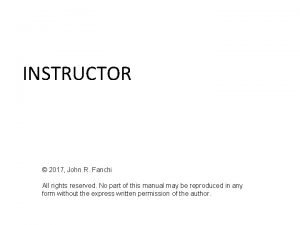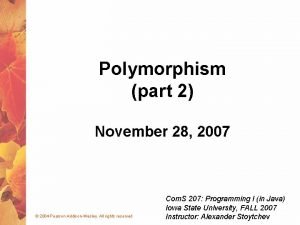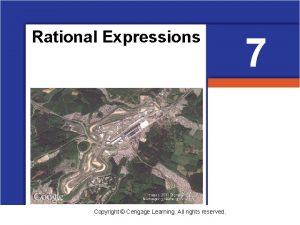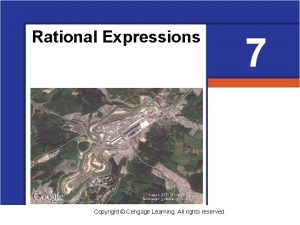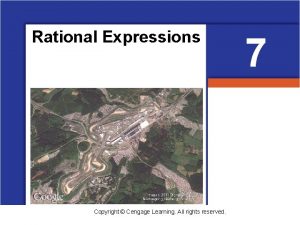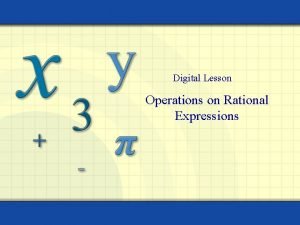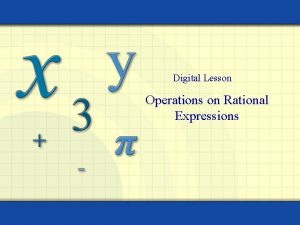Rational Expressions Copyright Cengage Learning All rights reserved




























- Slides: 28

Rational Expressions Copyright © Cengage Learning. All rights reserved. 7

SECTION 7. 1 Reducing Rational Expressions to Lowest Terms Copyright © Cengage Learning. All rights reserved.

Objectives A Find the restrictions on the variable in a rational expression. B Reduce a rational expression to lowest terms. C Work problems involving ratios. D Use the rate equation to work problems involving ratios. 3

Reducing Rational Expressions to Lowest Terms We have defined the set of rational numbers to be the set of all numbers that could be put in the form , where a and b are integers (b 0). 4

Reducing Rational Expressions to Lowest Terms For the rational expression the polynomial on top, is called the numerator, and the polynomial on the bottom, is called the denominator. 5

Restrictions on Variables A 6

Restrictions on Variables When working with rational expressions, we must be careful that we do not use a value of the variable that will give us a denominator of zero. Remember, division by zero is not defined. 7

Example 1 State the restrictions on the variable in the following rational expressions: a. b. Solution: a. The variable x can be any real number except x = 3 since, when x = 3, the denominator is 3 – 3 = 0. We state this restriction by writing x 3. 8

Example 1 – Solution cont’d b. If we factor the denominator, we have By applying our knowledge of the zero-factor property if either of the factors is zero, then the whole denominator is zero. Our restrictions are and since either one makes 9

Restrictions on Variables We will not always list each restriction on a rational expression, but we should be aware of them and keep in mind that no rational expression can have a denominator of zero. 10

Restrictions on Variables The two fundamental properties of rational expressions are listed below. 11

Reducing Rational Expressions B 12

Reducing Rational Expressions Let's see how the fraction is reduced to its lowest terms. 13

Reducing Rational Expressions The same procedure applies to reducing rational expressions to lowest terms. The process is summarized in the following rule: 14

Example 2 Reduce to lowest terms. Solution: We begin by factoring. Notice that both polynomials contain the factor If we divide the numerator by we are left with If we divide the denominator by we are left with 15

Reducing Rational Expressions It is convenient to draw a line through the factors as we divide them out. It is especially helpful when the problems become longer. 16

Example 3 17

Example 4 18

C Ratios 19

Ratios Let’s start with a definition. As you can see, ratios are another name for fractions or rational numbers. They are a way of comparing quantities. Since we also can think of as the quotient of a and b, ratios are also quotients. 20

Ratios The following table gives some ratios in words and as fractions. 21

Example 7 A solution of alcohol and water contains 49 milliliters of water and 21 milliliters of alcohol. Find the ratio of alcohol to water and of alcohol to the total volume of the solution. Solution: The ratio of alcohol to water is 21 to 49, or 22

Example 7 – Solution cont’d The amount of total solution volume is milliliters. Therefore, the ratio of alcohol to total solution is 21 to 70, or we can say that the concentration of alcohol in the solution is 30%. 23

D Rate Equation 24

Rate Equation You use rate equation on an intuitive level when you are estimating how long it will take you to drive long distances. For example, if you drive at 50 miles per hour for 2 hours, you will travel 100 miles. Here is the rate equation: The rate equation has two equivalent forms, the most common of which is obtained by solving for r. 25

Rate Equation 26

Example 8 The Forest Chair Lift at Northstar Ski Resort in Lake Tahoe is 5, 603 feet long. If a ride on this chair lift takes 11 minutes, what is the average speed of the lift in feet per minute? 27

Example 8 – Solution To find the speed of the lift, we find the ratio of distance covered to time. (Our answer is rounded to the nearest whole number. ) Note how we separate the numerical part of the problem from the units. 28
 Copyright 2015 all rights reserved
Copyright 2015 all rights reserved Copyright 2015 all rights reserved
Copyright 2015 all rights reserved Dell all rights reserved copyright 2009
Dell all rights reserved copyright 2009 Copyright © 2018 all rights reserved
Copyright © 2018 all rights reserved Copyright cengage learning. powered by cognero
Copyright cengage learning. powered by cognero Specification by example
Specification by example All rights reserved sentence
All rights reserved sentence Creative commons vs all rights reserved
Creative commons vs all rights reserved Confidential all rights reserved
Confidential all rights reserved All rights reserved example
All rights reserved example 2012 pearson education inc
2012 pearson education inc Microsoft corporation. all rights reserved.
Microsoft corporation. all rights reserved. Microsoft corporation. all rights reserved
Microsoft corporation. all rights reserved Microsoft corporation. all rights reserved
Microsoft corporation. all rights reserved Pearson education inc. all rights reserved
Pearson education inc. all rights reserved Warning all rights reserved
Warning all rights reserved All rights reserved c
All rights reserved c Quadratic equation cengage
Quadratic equation cengage Warning all rights reserved
Warning all rights reserved Confidential all rights reserved
Confidential all rights reserved Microsoft corporation. all rights reserved
Microsoft corporation. all rights reserved Pearson education inc. all rights reserved
Pearson education inc. all rights reserved 2017 all rights reserved
2017 all rights reserved Pearson education inc all rights reserved
Pearson education inc all rights reserved Pearson education inc. all rights reserved
Pearson education inc. all rights reserved Confidential all rights reserved
Confidential all rights reserved Confidential all rights reserved
Confidential all rights reserved R rights reserved
R rights reserved Rights reserved
Rights reserved



























